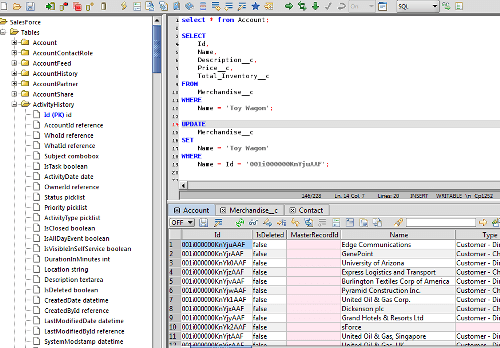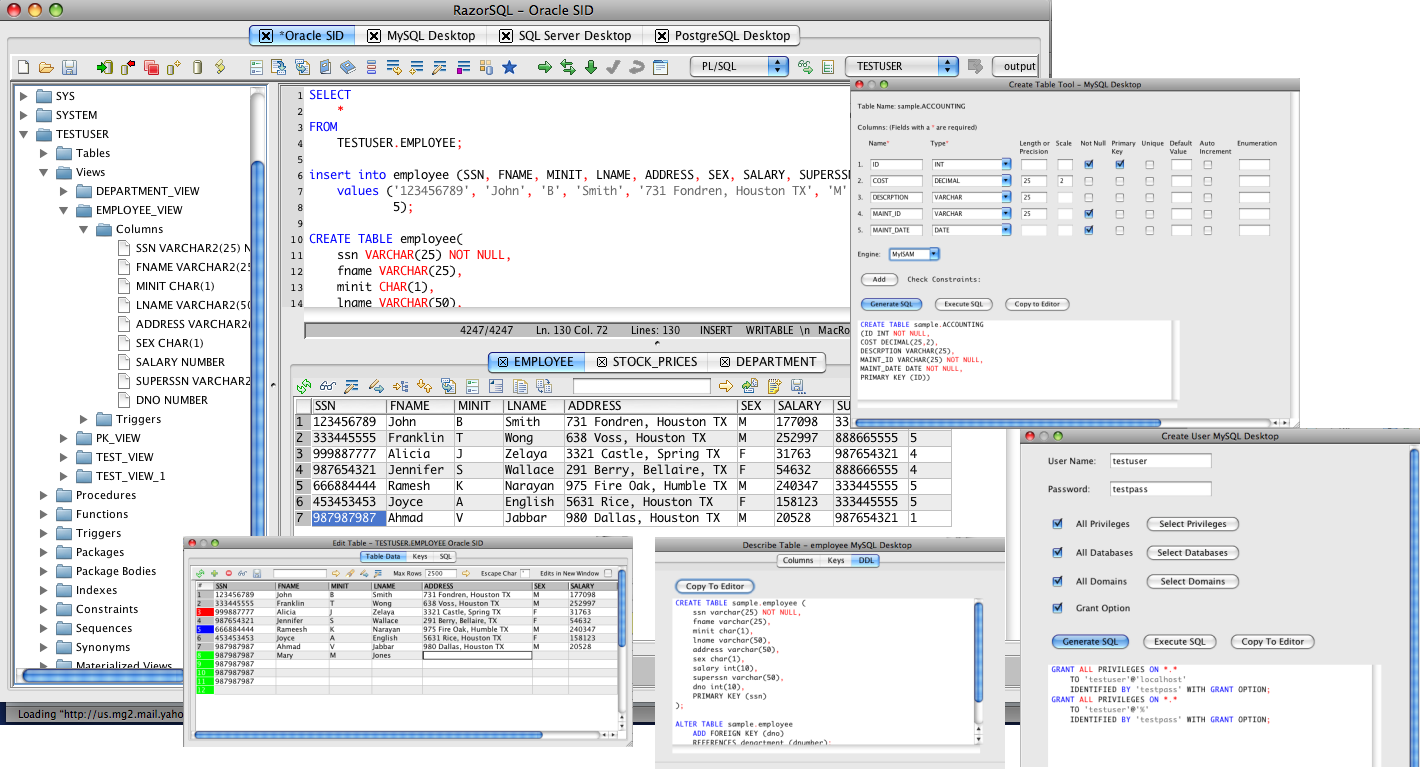Dynamodb Sql Editor For Mac
The following sections show how to connect to DynamoDB from two driver managers available on Mac OS X, iODBC and unixODBC; you will provide the necessary connection properties in a DSN and execute SQL to DynamoDB. Authenticating to DynamoDB To authorize DynamoDB requests, provide the credentials for an administrator account or for an IAM user with custom permissions: Set AccessKey to the access key Id.
Set SecretKey to the secret access key. Obtaining the Access Key To obtain the credentials for your AWS root account, follow the steps below:. Sign into the AWS Management console with the credentials for your root account. Select your account name or number and select My Security Credentials in the menu that is displayed. Click Continue to Security Credentials and expand the Access Keys section to manage or create root account access keys. To obtain the credentials for an IAM user, follow the steps below:.
Sign into the IAM console. In the navigation pane, select Users. To create a new IAM user, click Add User.
To create or manage the access keys for a user, select the user and then select the Security Credentials tab. Connecting to DynamoDB In addition to the AccessKey and SecretKey properties, you can optionally set Domain and Region. Set Region to the region where your DynamoDB data is hosted.
Set Domain if you want to use a domain name you have associated with AWS. Using a Driver Manager ODBC-compliant applications connect to the driver through a driver manager. After you connect, the driver manager loads the driver and passes function calls from the application to the driver. The driver manager also implements some functions for metadata discovery about the registered drivers and DSNs. DSNs and drivers can be defined for a specific user or system wide. Ensure that you install the driver after installing a driver manager: The installation modifies the driver manager configuration files, if they exist, to register the driver with iODBC and unixODBC and create system DSNs with empty values for commonly required properties. IODBC On Mac OS X, the CData ODBC Driver for DynamoDB 2016 is preconfigured for use with the iODBC driver manager, as are many other products like Filemaker Pro and Tableau.
The iODBC installation installs its own GUI, the iODBC Administrator, and several utilities for testing the connection and executing SQL queries. You can find the latest version of iODBC on the iODBC site. Note: Other GUIs that use iODBC are available: The ODBC Administrator tool can be downloaded from the Apple support site. However, it is no longer maintained. As an alternative, you can use the ODBC Manager tool from Actual Technologies. Using the iODBC Administrator You can create user DSNs, which are restricted to the currently logged in user, by opening the iODBC Administrator from Launchpad.
Dynamodb Update Record

To modify the system DSN installed by the driver or create a system DSN, you will need to open the iODBC Administrator with elevated permissions. To do so, you can enter the following command into a terminal: sudo /Applications/iODBC/iODBC Administrator.app/Contents/MacOS/iODBC Administrator Another alternative is to enable the root user on your system and then log in under that user. Please refer to the Apple documentation for more information. After opening the iODBC Administrator, you will see the CData DynamoDB Source listed under the System tab. Select the DSN and click the Configure button to set connection properties as name-value pairs. Using the iODBC Configuration Files It is recommended to use the iODBC Administrator GUI to create ODBC data sources; however, you can also modify the configuration files of the iODBC driver manager, odbc.ini and odbcinst.ini.
Odbc.ini ODBC data sources are defined in sections in the odbc.ini file. Privileges Path User /Users/myuser/Library/ODBC/odbc.ini System /Library/ODBC/odbc.ini The driver installation creates a system DSN with empty values for commonly required properties. Modifying iODBC's system-wide settings requires elevated permissions; to do so, you can use the sudo command to open a text editor from the terminal.
For example: sudo nano /Library/ODBC/odbc.ini In addition to the connection properties required to connect to your data source, the Driver property specifies either a driver definition in the odbcinst.ini file or the path to the driver library. You can also define User and Password properties in this section. CData DynamoDB Source Driver = CData ODBC Driver for DynamoDB MyConnectionProperty1 = My Value1 MyConnectionProperty2 = My Value2 Additionally, in the ODBC Data Sources section, the DSN must be set to a driver defined in the odbcinst.ini file. For example: ODBC Data Sources CData DynamoDB Source = CData ODBC Driver for DynamoDB odbcinst.ini This file contains ODBC drivers registered with the driver manager. With iODBC, drivers can be available to only one user account or drivers can be available system wide.


The installation of the driver automatically registers the driver, enabling system-wide access. Privileges Path User /Users/myuser/Library/ODBC/odbcinst.ini System /Library/ODBC/odbcinst.ini Drivers are defined in sections in the odbcinst.ini file. The section name specifies the name of the driver.
In this section, the Driver property specifies the path to the driver library. The driver library is the.dylib file located in the lib subfolder of the installation directory, by default in /Applications/CData ODBC Driver for DynamoDB. CData ODBC Driver for DynamoDB Driver = /Applications/CData ODBC Driver for DynamoDB/lib/libdynamodbodbc.dylib The ODBC Drivers section must also contain a property with the driver name, set to 'Installed'.
ODBC Drivers CData ODBC Driver for DynamoDB = Installed Testing the Connection You can use the iODBC Demo to connect to DynamoDB and execute SQL queries. IODBC Demo Follow the procedure below to connect from the iODBC Demo:.
This Time Zone Converter (Classic) calculates the time difference between several locations. Free download time converter edt to jst for mac.
Open Launchpad and search for 'iODBC'. If you need to connect to DynamoDB from an application that can use only the ANSI ODBC API, click iODBC Demo Ansi. Otherwise, click iODBC Demo Unicode. In the Environment menu, click Open Connection. Select the DSN on the corresponding tab and test the connection. You can now execute SQL statements to DynamoDB: In the SQL menu, click Execute SQL. UnixODBC The unixODBC driver manager is widely supported by Python, Ruby, and other scripting languages.
Installing unixODBC You can use the Homebrew package manager to install prebuilt binaries. To install Homebrew, run the following command: /usr/bin/ruby -e '$(curl -fsSL After installing Homebrew you can install unixODBC with the following command: brew install unixodbc Configuring the Driver The driver can easily be configured for the unixODBC driver manager by modifying its configuration file, cdata.odbc.dynamodb.ini, which must be located next to the driver library.
The driver library is the.dylib file located in the lib subfolder of the installation directory, by default /Applications/CData ODBC Driver for DynamoDB. In the configuration file, set the DriverManagerEncoding property to UTF-16.
(On Mac OS X, the driver defaults to the encoding used by iODBC, UTF-32.) Driver DriverManagerEncoding = UTF-16 Using the unixODBC Configuration Files The unixODBC driver manager reads information about drivers from an odbcinst.ini file and about data sources from an odbc.ini file. Odbc.ini ODBC data sources can be accessible by only specific users or system wide. Privileges Path User /Users/myuser/.odbc.ini System /usr/local/etc/odbc.ini The driver installation creates a system data source with empty values for commonly required connection properties. You can access it in the terminal with a command like following: nano /usr/local/etc/odbc.ini In addition to the connection properties required to connect to your data source, the Driver property specifies either a driver definition in the odbcinst.ini file or the path to the driver library. You can also define the User and Password properties in this section. CData DynamoDB Source Driver = CData ODBC Driver for DynamoDB Description = My Description MyConnectionProperty1 = My Value MyConnectionProperty2 = My Value2 odbcinst.ini The driver installation registers the driver with unixODBC, enabling system-wide access, by creating an entry in this file.
Dynamodb Query
Privileges Path System /usr/local/etc/odbcinst.ini The name of the section is the driver name. The Driver property specifies to the path to the driver library. CData ODBC Driver for DynamoDB Driver = /Applications/CData ODBC Driver for DynamoDB/lib/libdynamodbodbc.dylib Testing the Connection You can use the isql tool, available in most unixODBC packages, to test the connection and execute SQL queries to DynamoDB.
When testing the connection, use the -v flag to output any messages from the driver manager and the driver. Isql -v 'CData DynamoDB Source' Uninstalling the Driver The easiest way to uninstall is to open Terminal and run the included uninstall.sh script, located in the installation directory.
To ensure that the driver has sufficient permissions to remove all of the installed files, you will need to run the script as root or with sudo. Note that this script needs to be run from the installation directory, so you will need to run both of the following commands, or adjust the first command to your installation directory. Cd /Applications/CData ODBC Driver for DynamoDB sudo./uninstall.sh.